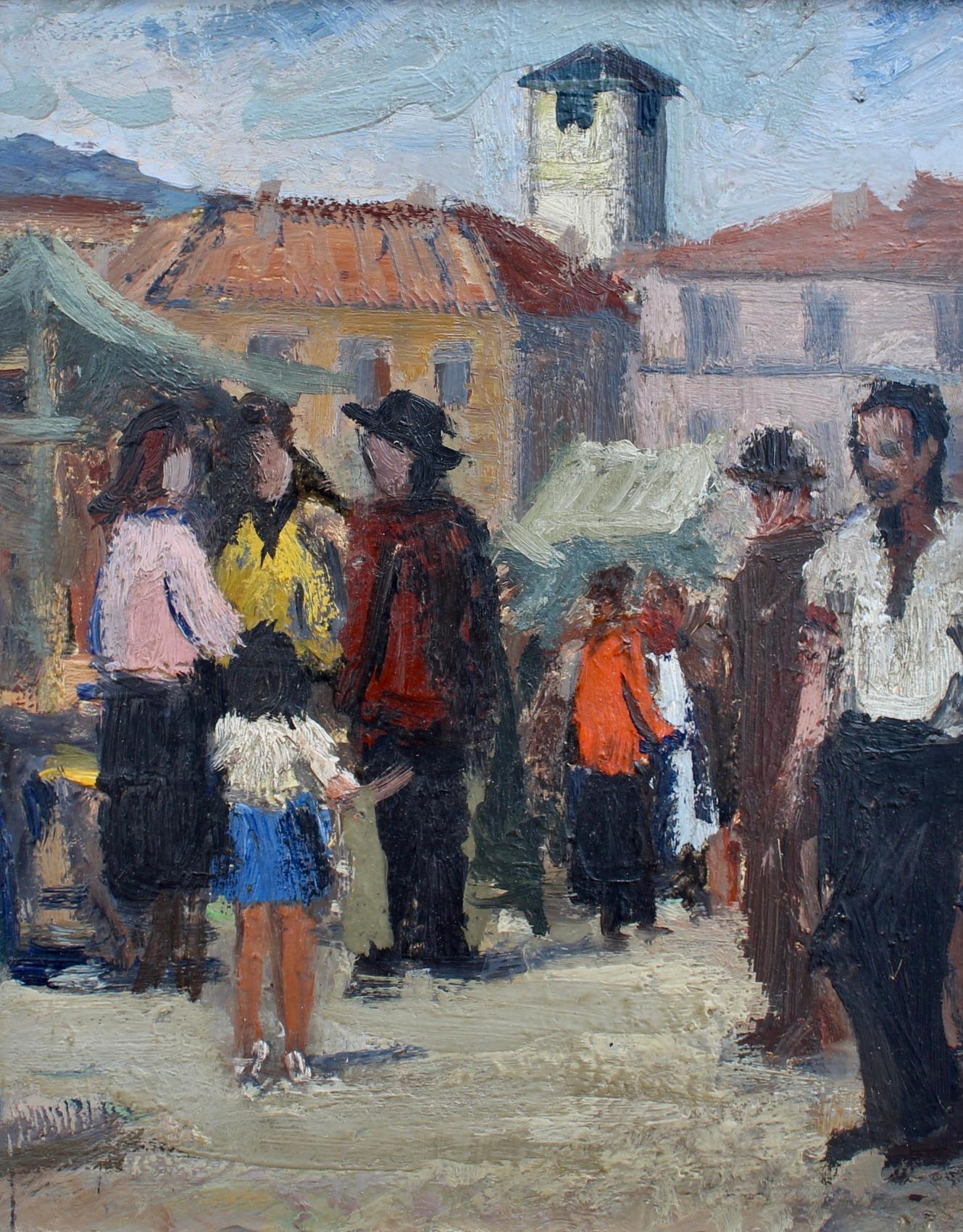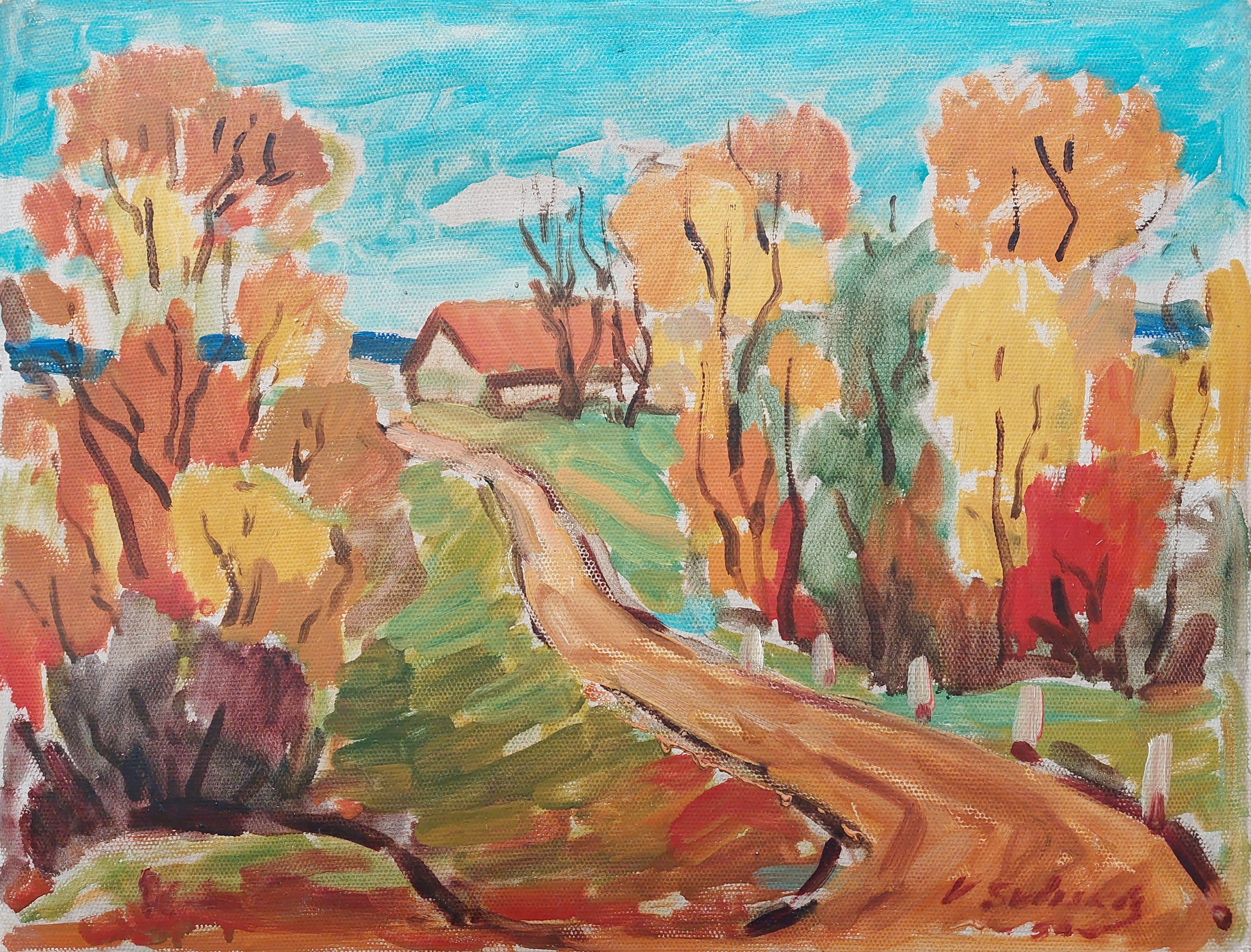Items Similar to 'Words to the Wise', African American Memento Mori, Skeletons, Bay Area, Black
Want more images or videos?
Request additional images or videos from the seller
1 of 11
John Diallo Jones'Words to the Wise', African American Memento Mori, Skeletons, Bay Area, Black1972
1972
About the Item
Signed on palette, lower right, 'John Diallo Jones' (American, 20th century) and dated 1992.
A dramatic figural oil showing the artist flanked by two whispering skeletons, one of which is grasping him firmly him by the throat.
Born John H. Jones, Diallo Jones was born and raised in rural Arkansas. His interest in art was encouraged in grade school and, after moving to California as a teenager, he was able to pursue his passion for art. Diallo Jones currently lives and works as a muralist in San Francisco and is credited in the mural "Soul Journey" (2000). He is also a contributor to the Precita Eyes Muralists Association, a mural arts organization devoted to enriching and beautifying urban environments through community mural collaborations.
- Creator:John Diallo Jones (American)
- Creation Year:1972
- Dimensions:Height: 24 in (60.96 cm)Width: 20 in (50.8 cm)Depth: 0.13 in (3.31 mm)
- Medium:
- Movement & Style:
- Period:
- Condition:restoration, minor corner bumping, minor marks; unframed; shows well.
- Gallery Location:Santa Cruz, CA
- Reference Number:1stDibs: LU34410718702
About the Seller
5.0
Platinum Seller
These expertly vetted sellers are 1stDibs' most experienced sellers and are rated highest by our customers.
Established in 1982
1stDibs seller since 2013
629 sales on 1stDibs
Typical response time: <1 hour
- ShippingRetrieving quote...Ships From: Santa Cruz, CA
- Return PolicyA return for this item may be initiated within 3 days of delivery.
More From This SellerView All
- 'Flamenco Dancer', Wisconsin, Paris, Académie Julian, Art Institute of ChicagoLocated in Santa Cruz, CASigned lower right, 'Grill' for André Joseph Grill (American, 1916-1985) and painted circa 1955. A light-hearted and animated study of a young flamenco dancer painted when the artist was in his forties. Born in Milwaukee, Wisconsin, Andre Grill...Category
1950s Expressionist Figurative Paintings
MaterialsOil, Laid Paper
- 'Woman Sleeping', Large Modernist Figural Oil, Buenos Aires, Argentina, PortlandBy Julio LavallenLocated in Santa Cruz, CASigned lower left, 'Lavallen', dated 1987 and titled verso 'Mujer Dormida' (Woman Sleeping). A large figural oil painting of a young woman shown reclining on a sofa. Julio Lavallen...Category
1980s Expressionist Figurative Paintings
MaterialsCanvas, Oil
- 'Carnival Figures', New York Exhibited Oil, Mid-century Woman Artist, TheaterBy Dorothy EbensteinLocated in Santa Cruz, CASigned lower center, 'Ebenstein' titled verso, 'Seduction' and painted circa 1966. Accompanied by 1966 exhibition label from Barzansky Galleries, New York. A substantial, Expression...Category
1960s Expressionist Figurative Paintings
MaterialsCanvas, Oil
- 'Still Life with Blue Jug', Contemporary California Expressionist artistBy Anthony McNaughtLocated in Santa Cruz, CAInitialed lower right, 'AEM'; for Anthony Eustace McNaught (American, born 1952) additionally signed verso, 'Anthony McNaught', titled 'Still Life with Blue Jug', and dated 2019. This Post-Impressionist and Expressionist artist studied at the Esalen Institute with Erin Gafill...Category
2010s Expressionist Figurative Paintings
MaterialsOil, Canvas
- 'Chariot', San Francisco Bay Area Abstraction, Mid-Century, Maxwell GalleryLocated in Santa Cruz, CASigned lower left, 'Ide' for Tom Ide (Canadian-American, 1919-1996) and dated 1965. Ide first studied at the Art Institute of Chicago (1951-1955) before movin...Category
1960s Expressionist Abstract Paintings
MaterialsCanvas, Oil
- 'Go, Igor, Go!', 1960's Night Club Go-Go Dancers, Large Post-Impressionist OilLocated in Santa Cruz, CASigned lower right, 'Phillips' for Dick Phillips (American, 20th century) and painted circa 1965. Additionally signed, verso, on stretcher bar, 'Dick Ric...Category
1980s Expressionist Figurative Paintings
MaterialsCanvas, Oil
You May Also Like
- Nandor Vagh Weinmann, Oil on cardboard, Naked Back, 1930sLocated in Saint Amans des cots, FROil on cardboard by Nandor VAGH WEINMANN (1897-1978), France, 1930s. Naked back. With frame: 64x56 cm - 25.2x22 inches ; without frame: 46x38cm - 18.1x15 inches. 8F format. Signed "Nandor V. Weinmann" lower left. In its Montparnasse frame. Very good condition. Born October 3, 1897 in Budapest, Nándor is the older brother of Elemer and Maurice Vagh-Weinmann. He came to Paris to present his work in 1931. He died on December 12, 1978 near Montereau (Seine-et-Marne) following an automobile accident. He is the most colorful of the three “expressionist” brothers. Painter of figures, landscapes, especially open mountains, and bouquets in bright colors. He is also a religious painter and then finds the tragic condition. Born in BUDAPEST on October 3, 1897, Nandor Vagh Weinmann belongs to a profoundly artistic people. Living in the heart of Central Europe where they came from Asia a millennium ago, the Hungarians have preserved a strong ethnic individuality whose mark is their very synthetic, non-Indo-European language. Resistant to secular invasions, they have kept the virtues of a very ancient humanity that have become rare in our modern world, especially since their way of life has remained essentially rural until today. In the arts they know how to express a generous, extreme sensibility and by the poetic verb, by the musical rhythms and also by a popular art of a richness, an exceptional harmony. Until the age of thirty-four, during the decisive years of childhood and youth, Nandor Vagh Weinmann was intimately imbued with popular life and the soul of Hungary. From the capital where his father was a jeweler and had a family of ten children, Nandor was the fifth, he knew first of all the suburbs, the populated districts, the rigors in winter of the cold and the snow. A very mobile existence made him acquainted with all of Hungary, from the Danube to Transylvania, its infinite plains and its wild mountains, its immense villages with ample low houses, and its towns which are still immense villages. The painter is passionate about rustic works, harvest scenes, beautiful folk costumes. Coming into direct contact with the peasants, he learned to know their soul. These contacts gave the artist a direct feeling for popular life and soul, as Millet once understood the peasants of Barbizon and Normandy whose existence he shared. What fascinated Nandor Vagh Weinmann above all were the festivals which enlivened the dreary life of the countryside, the circuses, the merry-go-rounds, the gypsies unleashing orgies of music, light and color. In the party, and especially the Hungarian party, the whole soul of a people, all its energy, its need for movement, for intensity, is expressed in its pure state and realizes the primary and essential form of what is called beauty. And as if melted at the party, there is the infinite steppe where herds of horses and oxen circulate where terrible storms sometimes roar where the seasons unfold their grandiose splendours. The young Nandor Vagh Weinmann nourishes his sensitivity to his inexhaustible shows, both eternal and always new, a sensitivity which very early declared itself that of a painter. Since the age of fourteen he painted, and since then he never stopped doing it. Two of his brothers Maurice, two years his junior, who had a remarkable career similar to that of Nandor and later Elemer who became Maurice's pupil, also devoted themselves to painting, despite family obstacles. And the three brothers united by a common passion worked together in Hungary and later in France. Painting was so much in the blood of the family, as in the past among the Veroneses, the Breughels, the Lenains, the Van Loos and so many other artistic dynasties, that three sons of the Vagh Weinmanns became painters in their turn. One of these, Emeric, son of Nandor, today occupies an important place in the contemporary school. Nandor, at fifteen, was a pupil of the Academy of Fine Arts in Budapest where he worked diligently, then at that of Vienna. He painted many portraits, but also landscapes, compositions and, by his relentless work, managed to live from his brush, although married very young and having to overcome many hardships. He therefore knew the hardships and miseries of life. These strongly impregnated his vision as an artist and explain the thrill of humanity that runs through all his work. A particularly moving experience was reserved for him at the age of twenty. In the hospitals of Budapest he had to paint extraordinary cases, operations, frightful wounds, the deformations to which our poor body is subjected by traumas and physiological decompositions. In these circumstances, it is not a question of gratuitous art, of formal research but of immediate, authentic expressions of our flesh and our being. We know that Breughel Velázquez and Goya had been haunted by the sight of cripples and of madmen Géricault by that of corpses. But life is ultimately stronger than anything, and it is life that Nandor Vagh Weinmann has passionately observed and translated through all the places where he has always painted on nature. Nothing stopped him. It happened to him to paint, for example in front of the mill of Linselles by a weather so cold, that nobody could stay outside, and that he did not leave the place before having finished his work. Because he works constantly on the ground, under the sky, in the silence he loves. His reputation is established. He exhibited at the national fair in Budapest, in the big cities of Hungary Szeged, Szombathely, Veszprém, Kaposvar. In 1931, like all artists in the world, he came to France. But unlike the others, he did not settle in Paris. Because Nandor Vagh Weinmann does not belong to this group of cosmopolitans that we call the School of Paris. He settled in Toulouse, where he remained for a long time with his brothers, and traveled throughout France, eager for new ties, exhibiting in the most diverse cities, in Bordeaux, Marseille, Lyon, Agen, Bayonne, Dax, Tarbes, Grenoble, Nice, Cannes, Strasbourg, Mulhouse, Colmar, Lille. He even crossed borders. He was in Saint Sebastian, in Geneva, and once in Egypt in 1927 where he painted King Fouad...Category
1930s Expressionist Figurative Paintings
MaterialsOil, Cardboard
- Hello LorettaBy Rob LynchLocated in Buffalo, NYAn original oil on MDF by contemporary conceptual painter Rob Lynch. This work was part of a recent pop up exhibition The Dreamer Who Dreams, which was curated to raise money for Th...Category
2010s Expressionist Figurative Paintings
MaterialsFiberboard, Oil
- Market Day in Piazza Grande Locarno SwitzerlandLocated in London, GB'Market Day in Piazza Grande, Locarno, Switzerland', oil on board, by unknown artist (1947-48). Locarno is an utterly charming Italian-speaking resort located on the northern shore o...Category
1940s Expressionist Figurative Paintings
MaterialsOil, Board
- Circle of Chaïm Soutine, Expressionist painting of Fishermen in a French harbourLocated in Harkstead, GBA very stylish image of a French harbour. Painted with great panache - wonderful brushwork and a vivid palette, reminiscent of the work of Chaim Soutine Circle of Chaïm Soutine (189...Category
20th Century Expressionist Landscape Paintings
MaterialsBoard, Oil
- Colorful autumn landscape. 1979, oil on cardboard, 46, 5x60 cmLocated in Riga, LVColorful autumn landscape. 1979, oil on cardboard, 46,5x60 cm Based on reality, artist painted expressionistic landscapes in which he dramatized the expression of shapes and colors....Category
1970s Expressionist Landscape Paintings
MaterialsCardboard, Oil
- At the autumn garden. Oil on cardboard, 80 x 57 cmLocated in Riga, LVAt the autumn garden. Oil on cardboard, 80x57 cm Janis Rikmanis (1901.5.IV – 1968.25.III) graduated Figurative painting studio of Latvia Art academy (1931). He took part in exhibiti...Category
1950s Expressionist Portrait Paintings
MaterialsOil, Cardboard
Recently Viewed
View AllMore Ways To Browse
Words Painting
Painting Of Words
To The Bay
Art By African American
John H
Art By African American Artists
Retro African American
African American Paintings
African American Painting
African American Art Paintings
African American Artist Painting
African American Art Signed
African American Paint
Paintings By African American Artists
African Figurative Painting
A Teenager
Works By African American Artists
Bay Area California Artist




